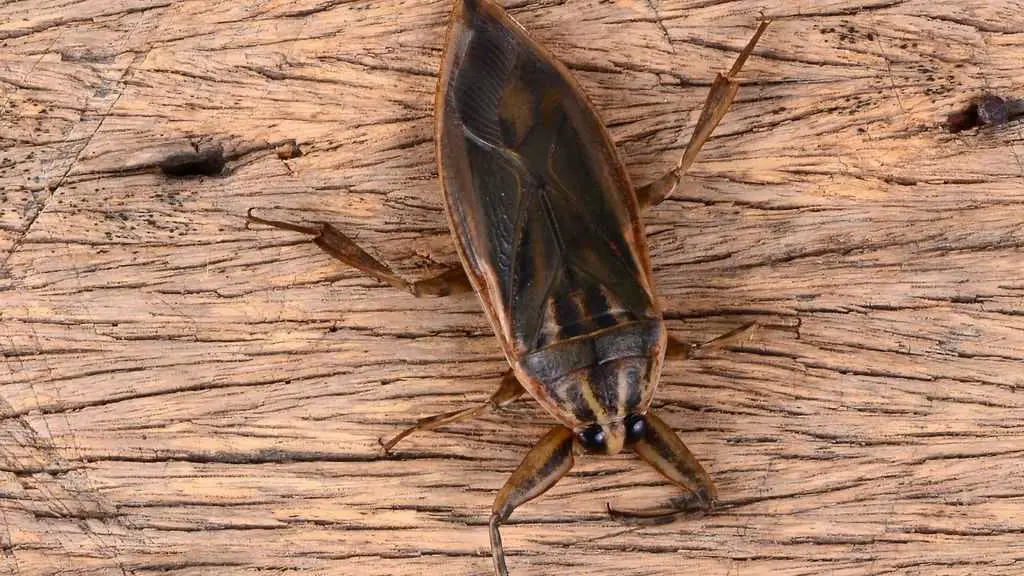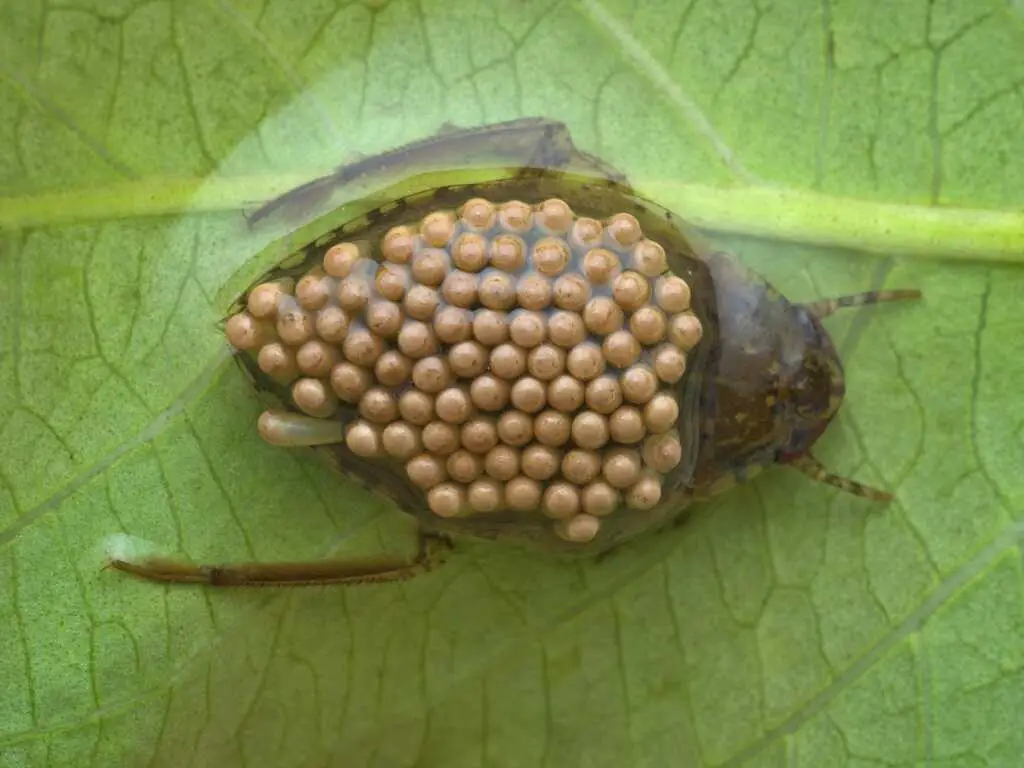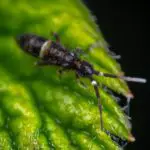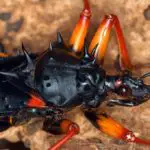Giant water bugs are aquatic predators with impressive size and fascinating hunting behavior, making them cool and unique pet insects. If you are keen to keep some giant water bugs, you are at the right place. In this article, I’ll teach you how to care for giant water bugs.
To keep giant water bugs, place them in a tank filled with water. They can be kept together or individually, depending on species. Add some emersed plants or partially submerged tree branches for the bugs to hide and hold onto. Feed the water bugs 2-3 times a week with minnows, crickets, roaches or mealworms.
Keeping giant water bugs is not difficult, but giving them good care so that they can flourish is not always easy. Continue reading to learn more on caring for giant water bugs.
Introduction to Giant Water Bugs

Giant water bugs are a group of aquatic insects belonging to the order Hemiptera, which are called the true bugs. They live in slow moving water, and feed on small aquatic animals including fish and water snails.
In certain places, the giant water bugs are also known as toe biters, water scorpions, alligator ticks or alligator fleas.
The most iconic group of giant water bugs is the genus Lethocerus. Certain Lethocerus species can grow up to more than 10 cm in length, making them the largest true bugs.
The giant water bugs have a pair of huge and prominent eyes, and a pair of short and barely visible antennas. Their body is flattened, and they have 2 pair of wings (surprise!).
Being an ambush predator, the giant water bugs spend most of their time hiding and waiting for their prey. When an unsuspecting prey gets near, the giant water bug quickly captures it with its strong and highly specialized forelegs.
Once they seize their prey, the giant water bugs inject venom into the prey using their sharp mouthparts called the rostrum. The venom liquefy the organs of the prey, allowing the giant water bugs to suck out the nutrients. This behavior is similar to that of the Horrid King assassin bugs, another fascinating pet bug.
While the giant water bugs are aquatic, they cannot breathe in water. Instead, they stick their respiratory tube or siphon out of water to breathe. To stay longer in water, they can keep the air bubbles underneath their wings. As they dive, the air bubbles slowly diffuse into their body, providing them with necessary oxygen.
Recommended Supplies and Resources
Here are my recommended supplies and resources that you can consider getting for your water bugs. I’ll earn a small commission from eligible purchases you make after clicking those links. It helps me maintain this site without additional cost to you.
Best Read – Assassin Bugs, Waterscorpions and other Hemiptera by Orin Mcmonigle

If you are looking for books about keeping giant water bugs, this is probably the only one that you can find. This book covers not only water bugs (aka water scorpions in its title), it also covers other interesting pets such as the assassin bug. The author, Orin Mcmonigle, has not only outlined the science you need to know about water bugs, but also the practical part of it from his experience handling arthropods for years. In short, this is the must-have and one-and-only book for water bug enthusiasts.
Other Supplies
Getting a Giant Water Bug
The easiest way to get giant water bugs is to buy them from online pet stores. Pet store owners are able to tell you the exact species, life stages and sometimes the sex of the water bugs you buy.
An adult giant water bug can live for about a year. Always buy nymphs to avoid getting adults which are too old.
Alternatively, you can collect water bugs from nature. They are free. However, you need to find a water body that has water bugs, and you may need to spend some extra effort identifying the species.
To collect water bugs, find a stream or pond where water bugs are spotted. Since water bugs usually hide in vegetation, run your fish net or strainer through the vegetation. With some luck, you will be able to scoop up the water bugs. Place the water bugs in separate deli cups while transporting them.
Enclosure
Giant water bugs can be kept in any container such as a cookie jar, deli cup and aquarium tank. Because they do not actively move around, a 64 oz container is sufficient for bigger species.
Aggressive species such as Lethocerus should be housed individually to avoid cannibalism. Other species may be kept communally in a larger tank.
It is important to have a lid on your enclosure because giant water bugs can fly! A pet that can swim and fly, isn’t that awesome!
Get some live or fake emersed plants in your aquarium so that there is a place for your water bug to latch on. In nature, the water bugs generally hide in plants to ambush their prey. You can also use dead tree branches, which is more economical.
You may need to add liquid fertilizer for your plants to flourish, if you are using live plants. Otherwise, you need to replace the plants every few months.
Add some driftwoods and aquascaping stones to make the enclosure look even better. Don’t forget to add lighting so that you can see your pet clearly.
If you have the luxury of using a large aquarium tank, you can build a paludarium for your giant water bug. This will further enhance your experience to the next level.
It is good to have a filtration system in your tank, especially if you are keeping minnows as feeders in your tank. However, it doesn’t really matter for your water bug.
If you plan to have a filter, be sure to use a low output one. Water bugs prefer slow moving instead of fast moving water.
Feeding Giant Water Bugs
As mentioned earlier, giant water bugs are predators. They feed on a variety of prey in nature.
To feed the giant water bugs, place a few minnows around the size of your water bug into the enclosure. The water bug will slowly prey on the minnows. Alternatively, you can hold a live cricket, cockroach or mealworm towards the water bug to feed it. Remove any carcasses asap to keep the water clean.
Crickets, roaches and mealworms can easily drown in water. Because they don’t swim in water, they may not be recognized as prey. Hence, you need to hold them towards the water bug for it to catch the prey. Use tweezers so that you don’t get bitten.
You can feed your water bug 2-3 times a week with 1 cricket or cockroach each time. If you are feeding it with minnows, put any amount of minnows inside the tank, and top up when the minnows are all gone.
If you are lucky to have a fish pond nearby, you can try to get some tadpoles and offer them to your water bug.
Handling Giant Water Bugs
Giant water bug is not a pet that you want to handle with bare hands. It can inflict painful bites that usually do not cause medical complications.
Having said that, if you are adventurous enough, you can hold the giant water bug by the side of its body, with its back facing your hand, as shown in the illustration below. That way, it cannot reach your hand with its rostrum. Be sure to hold it firm. The water bug is strong, and will try to struggle.
If you want to stay safe, you can either scoop the water bug out with a big cup, or use a pair of long tweezers to grab its legs.
You should also avoid handling giant water bugs near your face. This is because they can squirt noxious liquid from its anus, which can be irritating if it gets into your eyes.
Breeding
Identifying Male vs Female Giant Water Bugs
To breed giant water bugs, you need an adult male and female. However, it is not easy to identify them.
A male giant water bug has a smooth, rounded tip on its genital plate at the underside of its abdomen. Meanwhile, the genital plate of a female water bug is flattened. Here are some detailed illustrations that you can refer to.
Mating and Egg Laying

Feed your water bugs a day before. Then, place both the male and female water bugs in the same container, and leave them overnight. On the next day, you should see lots of eggs being laid.
Different species of water bugs have different behaviors in egg-laying. Lethocerus spp, for instance, lays eggs onto the emersed vegetation. These eggs drown in water!
To breed Lethocerus spp, make sure you place a partially-submerged branch or stick (or similar object) in the nursery container. That allows your water bug to climb and lay eggs.
Because Lethocerus eggs are laid on emersed vegetation, they will dry up if not taken care of. However, you don’t have to worry about that. The male will keep the eggs moist to ensure they survive.
All other non-Lethocerus species such as Abedus and Belostoma spp would lay eggs onto the back of the male water bugs. These eggs can survive in water, although the male will carry them to breathe in the air from time to time. Having an above-water platform such as a stone can smoothen the egg-laying process.
In either case, remove the female water bug from the nursery container. Do not remove the male since it will take care of the eggs.
The eggs typically hatch in 1-2 weeks. It is worth noting that the eggs gradually grow in size until they are almost double their initial size. This is a characteristic unique to giant water bugs.
Caring for Young Nymphs
If you intend to house the young nymphs in the same container, make sure you have a big one. Add enough plants in the container and provide them enough food to minimize cannibalism. Young nymphs can feed on small prawns or small fry.
The giant water bugs molt 5 times to become adults. Depending on species and rearing conditions, that may take 1-3 months
Additional Information
What should I do if my water bugs refuse to mate?
Make sure you have both male and female adult water bugs of the same species. Otherwise, they will not mate. Water bugs may also refuse to mate when it is too cold. Try to let them mate at room temperature.



